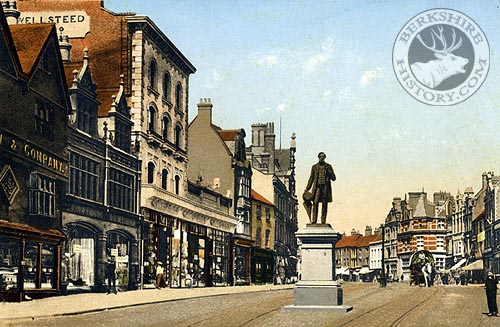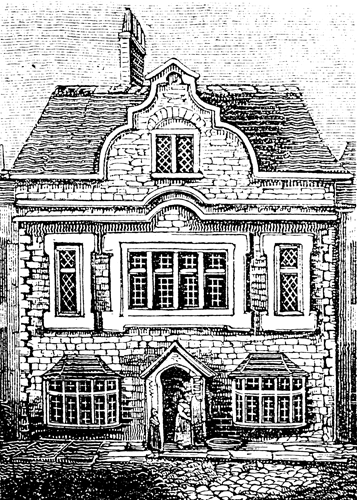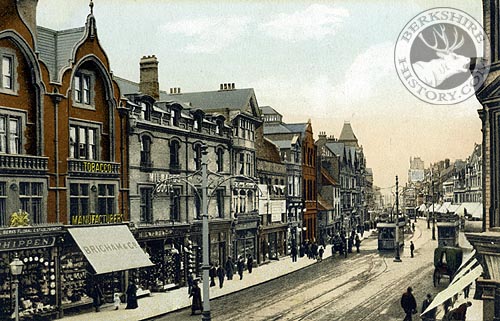 |
 |
|||
|
The name Broad Street, referring of course to its wide breadth, was apparently only first recorded in 1611. However, it was laid out, running westward from the southern edge of a new Market Place, by the monks of Reading Abbey, soon after the foundation of their monastery in 1120. At first, the name probably extended to the end of what is now called King Street. Sometime in the medieval period, the eastern end was divided down the centre into two narrower streets, extending form King Street to just beyond the Chain Street junction. The northern street was first recorded in the 13th century as Cheese Row, but was renamed Fisher Row around the late 16th century. Both names were derived from the types of shops chiefly trading there. The southern street, first recorded in the 14th century, was, for similar reasons, called Butcher Row, occasionally Ox Street. However, about 1827, these names seem to have largely been dropped and the central shops became Middle Row, whichever side they were on. The Broad Street numbers were then extended on the surrounding north and south sides. In September 1862, following recommendations made by the Board of Health some twelve years before, the unhygienic Middle Row, with its many slaughterhouses, was demolished - as originally proposed by Archbishop Laud in the 17th century - to create the wider Broad Street that suited its name. Proposals to call this area Queen Street were rejected. At the same time, the rubble was used to raise the level of the street. John Man has left us a rather shocking description of Butcher Row in 1808. Features Today Broad Street is the main shopping street in Reading, but this was not always the case, no matter what the monks who built it might have hoped. Minster Street was always the major commercial thoroughfare in medieval Reading and it largely remained so until the coming of the railway in 1840, when the focus of the town began to shift northwards towards the new railway station. Broad Street became the first street in the town to have the horse-drawn tramway system installed in 1879. This was replaced by electric trams in 1903 and then trolley-buses from 1939 to 1968. During the Tudor period, one of the greatest sons of the town was born in Broad Street:. William Laud, the Archbishop of Canterbury and advisor to King Charles I, was born on 7th October 1573 at the home of his parents, William Laud Senior and his wife, Lucy. Traditionally, this is said to have been on the north side at 47 Broad Street, which, for many years in the Victorian and Edwardian period, was the Dowsett Brothers' Brewery Tap Public House; then, from 1909 until 1957, the Vaudeville Electric Theatre (briefly renamed the Gaumont) "Reading's temple of colour and harmony". It eventually became Timothy White's and is is currently Boots Pharmacy. Laud Senior was a master clothier, as well as a prominent townsman and sometime mayor. "He kept not only many looms in his house, but many weavers, spinners and fullers at continual work". Reading was a major centre of the cloth industry at the time, processing the wool from the widespread sheep farms in the surrounding countryside.
In the late Georgian period, there was a pub called the Woolpack at No 27, four shops west of Cross Street. In the 1880s, William Silver Darter reminisced, " I remember as far back as 1814 that a large lead reservoir stood in the centre of Broad Street opposite the Wool Pack Inn, which was supplied with water by means of a three-action pump fixed in Mill Lane, its distribution being through wooden pipes. The only other means of obtaining water was from wells and pumps, but as some wells were 30 to 90 feet in depth, it was not only expensive but a very laborious affair to raise it by means of force pumps to the upper stories of a house." This 'waterhouse' continued in use until the water tower was built in Mill Lane in 1820. No 134 Broad Street, on the corner of Minster Street, was popularly known as Hounslow's Corner after the grocer's shop that occupied the building in Victorian times. It was a fine Tudor structure with the official name of Walsingham House because it was said to have been built by Sir Francis Walsingham as his Reading town house, where he could be near to Queen Elizabeth I when she was staying at her palace at the old Abbot's House. It had a prominent Royal coat-of-arms on a large diamond decorating the Broad Street frontage proclaiming that the Queen had once slept (or at least been entertained) there. Later, during the Civil War Siege of Reading, it was used as the headquarters for both Royalists and Roundheads. It was callously torn down in 1905. At the end of the 17th century, Reading became the scene of the only fighting of the 1688 Glorious Revolution. The protestant William of Orange had landed in the West Country and was marching on London to face his uncle, the unpopular Catholic King James II. Hearing that James' Irish troops were ensconced in Reading, he sent his Dutchmen ahead to meet them. The Irish were surprised by their arrival on 9th December and there was a rather confused battle across much of the town but centred on Broad Street. Hence it's name, the 'Battle of Broad Street'. The Irish eventually fled, as did the King soon afterward. From 1891, a statue of the biscuit manufacturer and philanthropist, George Palmer, stood at the eastern end of the street, facing down King Street. It was sculpted by George Blackall Simonds, a grandson of the founder of the Simonds' Brewery. In 1930, it was moved to Palmer Park to avoid traffic congestion, which ironically became irrelevant when Broad Street was pedestrianized in 1995. It stood just a little forward of the huge Corinthian columned entrance to a covered market and shopping arcade that, although much reduced in grandeur, until Sainsbury's was built in recent years, still connected through to the remaining parts of the arcade off Friar Street and the Market Place.
Another prominent feature of the south side of the street, at No 89, was the Broad Street Independent Non-Conformist Chapel. Now Waterstone's Bookshop, its beautiful rotunda with upper galleries and stained glass windows, dating from 1707, can still be seen inside. It was originally just this building, set back from the road, but was extended forward in 1892 with the towered entrance there today. It was frequented by many great town worthies, including the young William Blackall Simonds, who was christened there, and Justice Sir Thomas Noon Talfourd. Again, William Silver Darter reminisced, "I remember when very young being taken to Broad Street Chapel, and hearing a gentleman, who I think must have been Mr. Douglas, preach, probably his first sermon; all I recollect of him at that time was an awkward way he had of drawing himself up and then leaning over his pulpit. On leaving the chapel my father, seeing Talfourd, said to me: You should try and be as clever as he, for when he arrives at his home in all probability he will write down the sermon he has heard this morning." A few doors eastwards, on the corner of Chain Street, is the oldest building in the street. No. 96, now Cath Kidston's, is thought to be a 17th century shop. In Victorian times, it was the Post Office Tavern, and the old sign was, for many years, carefully preserved but hidden from view. It has, unfortunately, now been painted over. The name came from the other corner of Chain Street where the main town Post Office stood until it moved to Friar Street in 1923.
|
|||
| © Nash Ford Publishing 2016. All Rights Reserved. | ||||






 Today,
Broad Street joins Oxford Road to King Street. It starts at No. 1 in the
north-east (Butter Market corner) and runs to No. 74 in the north-west (West
Street corner). No. 75 is on the opposite side of the road in the south-west
(St. Mary's Butts corner) and runs to No. 134 in the south-east (
Today,
Broad Street joins Oxford Road to King Street. It starts at No. 1 in the
north-east (Butter Market corner) and runs to No. 74 in the north-west (West
Street corner). No. 75 is on the opposite side of the road in the south-west
(St. Mary's Butts corner) and runs to No. 134 in the south-east ( Brewing was another
prominent industry in the town and Dowsett Brothers were not the only brewery in
Broad Street. Ferguson & Sons' Angel Brewery stood on the south side at No
116, with the Brewery Tap next door. Both were immediately opposite the entrance
to Cross Street, with the 'Olde Curiosity Shoppe' on the western corner at No
24. It is often suggested that this was the inspiration for Charles Dickens'
novel of the same name, since he visited Reading a number of times; but this
seems unlikely, especially as there is a similar shop still extant near Aldwych.
At the south-western end of Broad Street at No 83 was the Broad Street Brewery
and Brewery Tap (in the 1960s, a pub called the Peacock). This was on the site
of the very first
Brewing was another
prominent industry in the town and Dowsett Brothers were not the only brewery in
Broad Street. Ferguson & Sons' Angel Brewery stood on the south side at No
116, with the Brewery Tap next door. Both were immediately opposite the entrance
to Cross Street, with the 'Olde Curiosity Shoppe' on the western corner at No
24. It is often suggested that this was the inspiration for Charles Dickens'
novel of the same name, since he visited Reading a number of times; but this
seems unlikely, especially as there is a similar shop still extant near Aldwych.
At the south-western end of Broad Street at No 83 was the Broad Street Brewery
and Brewery Tap (in the 1960s, a pub called the Peacock). This was on the site
of the very first  Broad Street is perhaps
best known today as the home, at Nos 110-111, of the Reading Department Store of the John Lewis
Partnership, formerly and still popularly called
Broad Street is perhaps
best known today as the home, at Nos 110-111, of the Reading Department Store of the John Lewis
Partnership, formerly and still popularly called